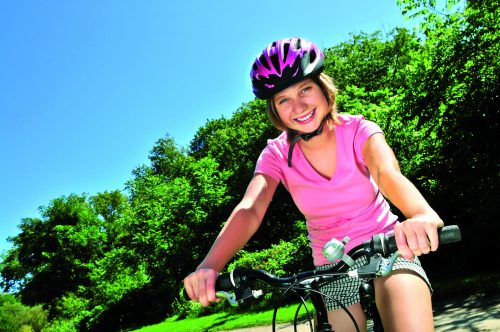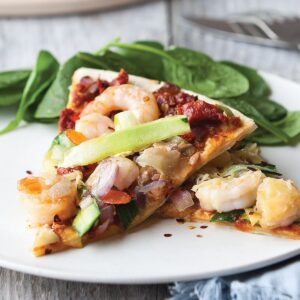
The energy needs of active teens are often much higher than your own. So when you’re feeding your son or daughter it may be time to rethink the rule book when it comes to how much food is ‘healthy’, says nutritionist Kristen MacKenzie.
If your teen exercises more than four times a week (such as participating in an organised sport that consists of at least one hour of vigorous exercise), their nutritional and energy requirements are going to be quite different to yours. Between learning, socialising, growing and intensive sports training, it’s no wonder your teenage son or daughter can empty the contents of the fridge in one go. While they require the same healthy foods you do, the portion sizes and the frequency of meals may differ from yours. Luckily, getting the balance right isn’t as tricky as you might think.
Is my teenager eating well?
Teenagers are renowned for wanting to flex their independence in every area of their life – including in their food choices. Lots of activity and the possibility of peer pressure to look a certain way may mean your teen is at risk of making poor food choices. Nutrients they might not be getting enough of include carbohydrates, protein, calcium, iron and essential fatty acids. With only one-third of young people in New Zealand reporting they consume adequate vegetables and fruit, and likely more than one quarter not having enough dairy foods, your teen may be at risk of being deficient in key vitamins, minerals and antioxidants.
What should I be feeding my teen?
For a highly active teenager, meeting daily energy and nutrient requirements can be very difficult. Here are some easy ideas for getting enough good-for-you food into their day:
Breakfast
Does your teenager get home after school and want to eat anything and everything within reach? If so, chances are they haven’t eaten enough throughout the day. A filling breakfast is the best way to start the day. Aim to include a low-fat dairy product, fruit and bread or cereal. If you are rushed, then fruit, juice, toast, cereal or cereal bars, low-fat yoghurt and milk drinks are good options. If your teen doesn’t like eating a big brekkie, or if they have sport or training before school, split breakfast into two smaller meals.
Snacks
Snack times are great opportunities to pack extra nutrition into a teen’s diet. If they play sport or attend training during dinnertime or other key eating times, snacks can be vital to maintaining energy levels. With all that growing to do, and all the exercise, there can actually be room for extra sugar in their diet (preferably coming from nutritious choices such as dried fruit and low-fat flavoured milks). A bit of extra fat can be OK, particularly if it’s coming from unsaturated fat sources such as nuts and avocados.
Some good snack ideas for your active teen include:
- low-fat yoghurt, reduced-fat custard, creamed rice or other low-fat dairy snacks
- trim milk and low-fat flavoured milk
- fruit, fruit juice, dried or canned fruit
- reduced-fat cheeses or cheese sticks
- sandwiches or cereals
- plain popcorn, crackers, pretzels or rice cracker snacks
- protein foods such as meat, hummus, nuts, seeds, eggs or baked beans.
Lunch and dinner
One of the most common challenges is making sure active teens have enough food in their school lunch. To ensure your teenager’s nutrient needs are met, encourage them to eat small meals throughout the day and always make sure that their lunch and dinner includes a protein source, a carbohydrate source and at least two serves of vegetables or fruit. Teach them what a balanced meal looks like, too, so they can make healthy choices on their own.
Growing bones – the importance of calcium
During adolescence bone mass is rapidly increasing and teenagers need 1300mg calcium each day to support this growth. This equates to around four glasses of low-fat milk each day. A New Zealand study of 15-18 year olds found that one-third of the boys and over one-third of the girls did not get enough calcium.
Peak bone mass, the highest strength and density our bones achieve, is reached in our mid-twenties and after this it slowly declines. Unfortunately, if teenagers don’t get adequate calcium, the peak bone mass they achieve will be lower than it could have been which can mean early osteoporosis when they’re older.
On the flip side, adequate calcium plus regular exercise is the best way to achieve the highest potential for their bones. So encourage your teens to have plenty of low-fat milk, yoghurt and cheese, and sardines – if they like them!
How much energy do teens need?
It is hard to know exactly how much energy your young athlete needs because it’s difficult to calculate the amount and intensity of the activity. There is also evidence that young athletes use more energy than adults when doing the same exercise. But low body weight and fatigue are two warning signs that there is an energy imbalance. If you are concerned, consult a health professional to ensure your teen is meeting their nutritional and energy requirements, and meeting the expected growth rates for their age.
Warning signs your young athlete may not be eating enough
- weight-loss
- stunted growth or short stature (compared to family members)
- susceptibility to colds and flu
- excessive tiredness
- sudden decreases in performance
- extreme fussiness or unbalanced vegetarian eating
- low self-esteem or negative body image
- irregular or delayed menstruation
- increased incidence of injuries, such as stress fractures.
Don’t forget
Consulting a dietitian or nutritionist is often money well spent.
www.healthyfood.com










